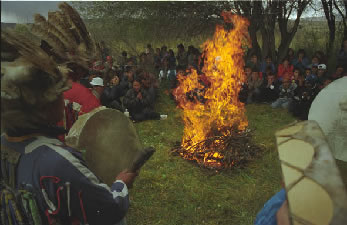

|
Shamanism Alive and Well: The 1999 Legacy of the First FSS Expedition to Tuva By Paul Uccusic © Shamanism, Fall/Winter 2000, Vol. 13, Nos. 1 & 2 This article describes the September 1999 Austrian FSS expedition to Tuva, a small Russian Republic in the Central Asian Steppe of Siberia. For comparative background on this article, readers may consult Vol. 7, No. 1, Vol. 8, No. 1, and Vol. 9, No. 2 for 1994, 1995, and 1996, respectively. In particular, the article shows the impact of the work done by Foundation teams in helping the Tuvans restore and maintain their shamanism. Of particular note is the continuing good health of the famous and beloved Tuvan actor, Kherteg Shiriin-Ool, who was healed of serious heart disease in a core shamanic circle in the summer of 1993. Additionally, the article describes some of the changes occurring in Russia since the collapse of the Soviet system. The author, Paul Uccusic, is now the Director of FSS Europa. Paul's account allows the reader to look over his shoulder as he and his Austrian colleagues cope with day-to-day conditions of life in a remote Russian Republic and as he describes shamanic practice there. Bill Brunton, Editor. To tell the truth, we never would have expected the incredible changes, the marvelous recovery, and the reorganization of Tuvan shamanism that has occurred since the summer of 1993, when the FSS mounted its first expedition to Tuva. We think this is mostly due to the “elder shamanic statesman,” Professor Kenin-Lopsan, and to the new head of the shamanic organization, Nikolai Oorzhak. We also should never forget the contributions of the late Heimo Lappalainen, who opened for Westerners the way to Tuva, Michael Harner, whose wisdom sent the first FSS expedition there, its leader Bill Brunton who represented Michael and helped to negotiate the cultural divide between the Tuvans and ourselves, and Larry Peters who, with the aid of the whole group and the compassionate spirits, was the instrument for healing for the most famous actor of Tuva, Kherteg Oolbezegovich Shiriin-Ool in a public session in the theater where this actor had been taken from his hospital-bound heart condition.1 In addition, the other members of that expedition: Tom and Tamia Anderson, Norman Benzie, Melinda Maxfleld, Roswitha Uccusic, and Gabriele Weiss, should be recognized for the important work they did for the Foundation and the Tuvans in documenting the expedition's work and helping to create and maintain the spiritual circle that was the root of success for the whole venture.
 Fire Ceremony at Chyraa-Bashi, Tuva, on September 22, 1999.
Fire Ceremony at Chyraa-Bashi, Tuva, on September 22, 1999.Photo by Paul Uccusic. Readers of Shamanism have followed two additional FSS expeditions to Tuva and have learned of the Tuvan shamans' travels to Europe and the United States . This article will describe the fourth FSS expedition to Tuva wherein five Austrians decided to “again climb the Sayan mountains ” (the mountains which encircle part of Tuva) and step into the “Land of the Eagles.”
This expedition had the following participants:
Preparations for the expedition were exhausting, as usual. We were reminded again that the Russian Federation is different from other countries. Flights booked in advance were cancelled, so arrangements had to be changed, with a loss of time and considerable money. Our route took us by air from Vienna to Frankfurt, from there to Moscow, and finally to Abakan. We then traveled from Abakan to Kyzyl (in Tuva) by hired minibus. Our return included an excursion to Irkutsk with an overnight stop, and then a six-hour flight from lrkutsk to Moscow, followed by an eight-hour layover at the airport before finally continuing on to Frankfurt and eventually, Vienna. Most of the hotels In the Russian Federation have begun remodeling, like the famous Rossiya at Moscow 's Red Square or the Angara in Irkutsk. They are rapidly approaching Western standards (and prices). Hotel employees are now available around the clock to serve guests, and one even gets annoying calls in their room from women offering massage and other services. The most impressive thing about Moscow is the speed of reconstruction of the old churches, a physical sign that religion has officially returned to Russia. The most important of these is in the northeast corner of Red Square. Through the aid of donations by Muscovites, the old cathedral of the “Godmother of Kazan” (a literal translation from the Russian: they do not say “Virgin Mary”) was reconstructed in a mere two years. The mausoleum of Lenin remains in the square. However, discussions about moving Lenin's body to another place and tearing down the building are ongoing. |
Articles
Please consider joining the Circle and receive the Foundation's journal, the Shamanism Annual as part of your benefits. |